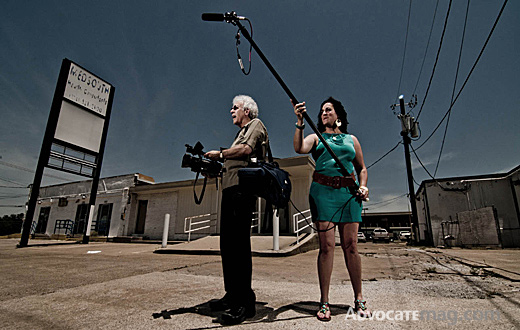
Allen Mondell and his daughter, Fonya Naomi Mondell, are both filmmakers, and they’re working on a documentary about North Henderson. Photo by Can Türkyilmaz
In grade school, Fonya Naomi Mondell invited her pals at the Greenhill School to her birthday party.
“Some of their parents were really worried about bringing their kids to this neighborhood,” she says.
Now 38, Mondell lives in her childhood neighborhood again, in a house just off North Henderson.
“Now I tell those same people where I live, and they think it’s so cool,” she says. Dramatic changes in the North Henderson area inspired Mondell to make a documentary film about the neighborhood with her father, filmmaker Allen Mondell.
Allen Mondell owns a film production and distribution company, Media Projects Inc., with his wife, Cynthia Salzman Mondell. They still live on Homer, where their daughter grew up.
Fonya first came up with the idea for the Henderson Avenue documentary about 10 years ago, and they started filming about two years ago. They’re taking their time with the Henderson Avenue documentary. For one thing, they both have full-time jobs. Fonya is an executive producer and director at Media 13, a production boutique in Dallas. And her dad is working on another feature-length documentary about the Peace Corps.
They have received some funding for their project, but not much, so they work on it as they have the money.
But they both feel it needs to be created over a long period of time. After all, it is a film about change.
“We want to show a process,” Allen Mondell says. “Even if the funding was all there, we would still want to take our time.”
In two years of filming, they already have seen a few businesses come and go, Fonya says.
The film has several elements: history, gentrification, neighborhood characters, and the ongoing struggle between commercial and residential sections of the neighborhood.
“We think it would be interesting for people to know how Henderson began in the early 19th century,” Allen Mondell says.
They still have a long way to go in researching the history. But they’ve found that Henderson began as a major thoroughfare between a train stop at the Katy Trail and the neighborhoods of East Dallas. Not so different from today.
One question that keeps coming up relates to gentrification. When the Mondells moved to the neighborhood in 1972, their neighbors were working-class Hispanics, gay couples and a few artists, plus the legacy set — people who had lived in the neighborhood since it was predominantly white and middle class. Now that the area is changing again, and more and more middle-class white people are moving in, where are their old neighbors going? Home values have increased 10-15 percent since the ’70s. But that also brings an increased tax bill, which has forced elderly and low-income people out of the neighborhood.
“We’re not saying it’s necessarily a bad thing,” Fonya says. “We’re just showing it in the film.”
Since they started filming, the majority of their time has been spent at neighborhood meetings. There is always some conflict between businesses and residents, the Mondells say.
“[New development] has brought a lot of good things to the neighborhood,” Fonya Mondell says. “But it’s also caused this issue with encroachment.”
Nightlife has taken over the neighborhood, and many neighbors want a better balance between day and nighttime uses. Parking is an issue almost throughout the neighborhood. Some residential streets have obtained “resident parking only” permits from the city. But there is a struggle with over-served revelers, car break-ins and traffic.
“In the neighborhood associations, you really find mixed opinions,” she says. “There are some people who don’t have a problem with the encroachment, and there are some who just can’t stand it, and they will fight it at every step.”
The neighborhood has never been static, and the Mondells have always loved that about it.
Nowadays, Allen Mondell says he’s amazed to see how vital Henderson is. There are always people walking and riding bikes. It has a new energy, he says.
“At the same time, there’s a toll to be paid for that,” he says. “Some benefit, and some don’t.”
Even though theirs is a film about Henderson, they think it will appeal to anyone interested in new urbanism. What’s happening on that street is happening on streets all over the place.
“It’s something that could happen anywhere,” Fonya says.





